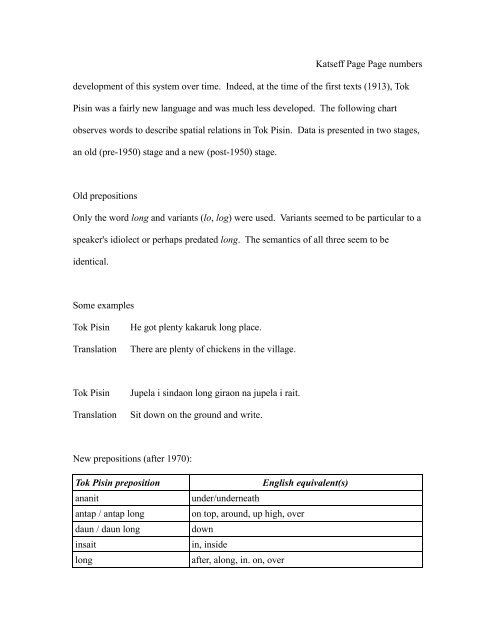The case of pidgin and creole languages - Linguistics
The case of pidgin and creole languages - Linguistics
The case of pidgin and creole languages - Linguistics
Create successful ePaper yourself
Turn your PDF publications into a flip-book with our unique Google optimized e-Paper software.
Katseff Page Page numbers<br />
development <strong>of</strong> this system over time. Indeed, at the time <strong>of</strong> the first texts (1913), Tok<br />
Pisin was a fairly new language <strong>and</strong> was much less developed. <strong>The</strong> following chart<br />
observes words to describe spatial relations in Tok Pisin. Data is presented in two stages,<br />
an old (pre-1950) stage <strong>and</strong> a new (post-1950) stage.<br />
Old prepositions<br />
Only the word long <strong>and</strong> variants (lo, log) were used. Variants seemed to be particular to a<br />
speaker's idiolect or perhaps predated long. <strong>The</strong> semantics <strong>of</strong> all three seem to be<br />
identical.<br />
Some examples<br />
Tok Pisin He got plenty kakaruk long place.<br />
Translation <strong>The</strong>re are plenty <strong>of</strong> chickens in the village.<br />
Tok Pisin Jupela i sindaon long giraon na jupela i rait.<br />
Translation Sit down on the ground <strong>and</strong> write.<br />
New prepositions (after 1970):<br />
Tok Pisin preposition English equivalent(s)<br />
ananit under/underneath<br />
antap / antap long on top, around, up high, over<br />
daun / daun long down<br />
insait in, inside<br />
long after, along, in. on, over

















